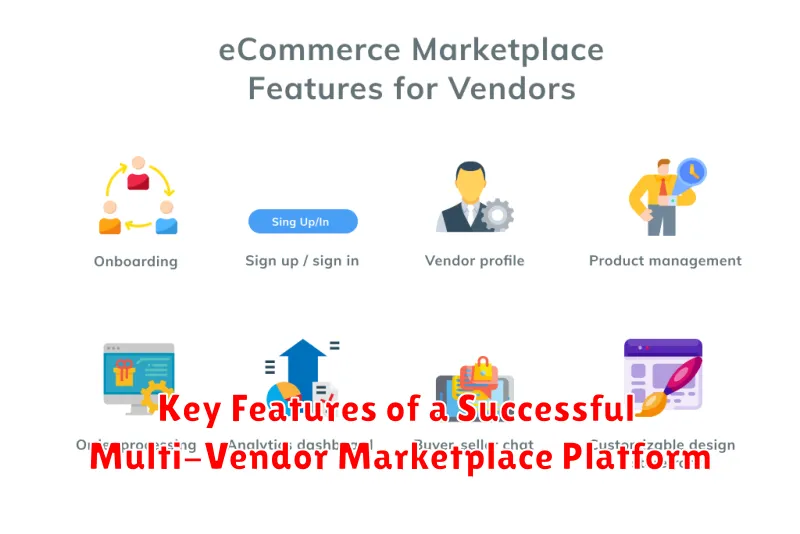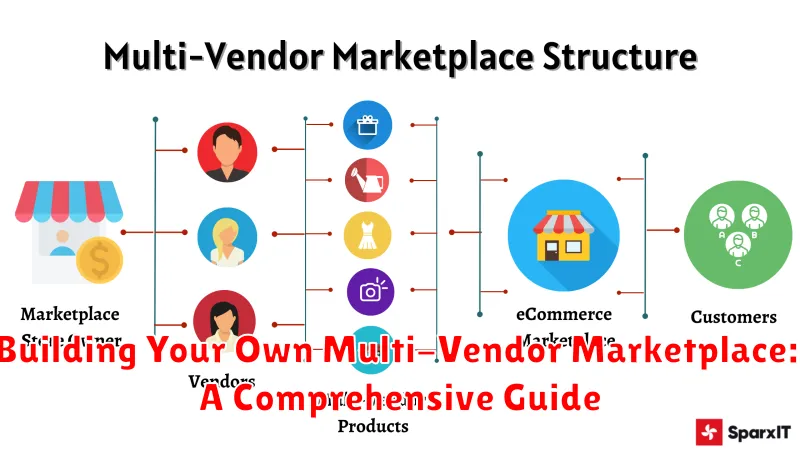Embarking on the journey of building your own multi-vendor marketplace? This comprehensive guide provides a roadmap to navigate the complexities of creating a thriving online platform. Whether you envision a niche marketplace or a broad-ranging e-commerce hub, understanding the key components is crucial. This guide will equip you with the knowledge necessary to build a successful multi-vendor marketplace, covering aspects from planning and development to marketing and ongoing maintenance. From defining your target audience and selecting the right platform to managing vendors and ensuring security, this resource offers valuable insights into each stage of the process. Learn how to create a scalable and profitable multi-vendor marketplace that caters to both buyers and sellers.
Building a multi-vendor marketplace demands careful consideration of various factors, including business models, revenue streams, and legal considerations. This guide delves into the essential elements of a successful marketplace, providing practical advice and best practices. Discover how to choose the optimal technology stack, design an intuitive user interface, and implement effective marketing strategies. We’ll explore the critical aspects of vendor management, payment processing, and order fulfillment, equipping you with the tools to build a robust and sustainable multi-vendor marketplace. From choosing the right features and functionalities to ensuring customer satisfaction, this guide offers a comprehensive overview of building a successful online business in the competitive marketplace landscape.
What is a Multi-Vendor Marketplace?
A multi-vendor marketplace is an e-commerce platform where multiple third-party sellers list and sell their products or services to customers. It acts as a single online storefront, providing a centralized hub for buyers to browse a diverse range of offerings from various vendors.
Unlike a traditional online store where a single business owns and manages all inventory, a multi-vendor marketplace facilitates transactions between buyers and independent sellers. The marketplace operator typically handles the platform infrastructure, marketing, payment processing, and sometimes even order fulfillment, while the sellers manage their own inventory, pricing, and customer service.
Think of it like a digital shopping mall. The mall owner provides the space and common amenities, but individual stores within the mall operate independently, offering their unique selection of merchandise.
Benefits of Creating a Multi-Vendor Marketplace
Creating a multi-vendor marketplace offers a range of advantages for business owners. It allows for rapid scalability, as you can expand your product offerings without needing to source inventory yourself. This also leads to increased product diversity, attracting a wider customer base.
Reduced financial risk is another key benefit. Instead of investing heavily in inventory, you rely on vendors to manage their own stock. This also frees up your time and resources, allowing you to focus on marketing and platform development.
Multi-vendor marketplaces often experience higher customer engagement due to the variety of products and vendors. This creates a competitive environment that can lead to better pricing and improved customer service.
Finally, these platforms offer multiple revenue streams, including commissions on sales, listing fees, and potentially advertising opportunities. This diversified income model contributes to a more stable and profitable business.
Key Features of a Successful Multi-Vendor Marketplace Platform

A thriving multi-vendor marketplace relies on a robust platform with key features that facilitate smooth operations and a positive user experience. These features are crucial for attracting both vendors and customers.
Vendor Management: Efficient vendor onboarding, profile management, and performance tracking are essential. This includes tools for product listing, inventory management, and order fulfillment.
Product Catalog Management: A centralized system for managing product listings, categories, and attributes is crucial for easy navigation and search. Search and filtering capabilities empower customers to find specific products quickly.
Secure Payment Gateway: A secure and reliable payment gateway is paramount for processing transactions and ensuring both vendor and customer protection. Multiple payment options enhance convenience.
Order Management System: Streamlined order processing, tracking, and management are vital for efficient operations. This includes automated notifications and order status updates.
Communication Tools: Integrated communication tools enable seamless interaction between vendors and customers, facilitating inquiries, support, and feedback.
Choosing the Right Platform for Your Multi-Vendor Marketplace
Selecting the right platform is crucial for the success of your multi-vendor marketplace. The platform will determine the functionality, scalability, and overall user experience. Consider these key factors when making your decision:
Key Considerations:
- Budget: Platforms range from free, open-source options to premium, enterprise-level solutions. Establish a clear budget early on.
- Scalability: Choose a platform that can handle growth in vendors, products, and traffic.
- Customization: The ability to customize the platform’s appearance and functionality is essential for creating a unique brand experience.
- Payment Gateway Integration: Ensure the platform supports secure and reliable payment processing options.
- Vendor Management Features: Look for features that streamline vendor onboarding, product management, and payout processes.
- SEO Friendliness: A platform optimized for search engines will help attract organic traffic to your marketplace.
Carefully evaluating these factors will help you choose a platform that aligns with your business needs and sets your marketplace up for success.
Step-by-Step Guide to Building Your Multi-Vendor Marketplace
1. Define Your Niche: Clearly identify the specific market segment your marketplace will serve. This focus will guide your platform’s features and marketing strategies.
2. Choose a Business Model: Decide how you’ll generate revenue. Common models include commissions on sales, subscription fees for vendors, or a combination of both.
3. Select Your Platform: Opt for a dedicated multi-vendor marketplace platform or consider customizing an existing e-commerce solution. Factor in scalability, features, and budget.
4. Design and Customize: Create a user-friendly and visually appealing interface. Branding and user experience are crucial for attracting both vendors and customers.
5. Onboard Vendors: Develop a streamlined onboarding process for vendors, including clear guidelines, documentation, and support resources.
6. Marketing and Promotion: Implement a comprehensive marketing strategy to attract both vendors and customers. Leverage social media, content marketing, and paid advertising.
7. Ongoing Management: Regularly monitor platform performance, address vendor and customer inquiries, and continually refine your marketplace based on user feedback and market trends.
Essential Integrations for Your Multi-Vendor Marketplace
Integrating the right tools and services is crucial for a successful multi-vendor marketplace. These integrations streamline operations, enhance the customer experience, and ultimately drive sales.
Payment Gateways are fundamental. Secure and reliable payment processing is essential for handling transactions from multiple vendors and ensuring smooth payouts. Consider integrating with popular gateways that offer diverse payment options.
Shipping and Logistics Integrations simplify order fulfillment. Integrating with shipping providers allows for automated tracking and streamlined delivery processes, crucial for managing orders from various vendors.
Inventory Management Systems help vendors track their stock levels. This integration prevents overselling and ensures accurate product availability information on the marketplace.
Customer Support Systems can be integrated to manage customer inquiries and complaints effectively. A centralized system facilitates communication and ensures timely responses to customer issues.
Marketing and Promotion Strategies for Your Multi-Vendor Marketplace
Driving traffic and sales is crucial for any marketplace. A multi-vendor platform requires a strategic approach to marketing and promotion, considering both the platform itself and the individual vendors.
Attract Vendors: Offer competitive commission rates, robust marketing tools, and a supportive community. Highlight the benefits of joining your platform through targeted outreach and industry events.
Empower Vendors: Provide resources and training to help vendors effectively market their own products within the marketplace. This could include workshops, webinars, or guides on best practices for product listings and promotions.
Platform-Wide Campaigns: Implement marketing strategies that benefit all vendors, such as social media campaigns, email marketing, and search engine optimization (SEO). Focus on building brand awareness and driving traffic to the platform.
Targeted Promotions: Run specialized promotions highlighting specific product categories or vendor groups. This can create excitement and attract niche audiences.
Loyalty Programs: Implement a customer loyalty program to encourage repeat purchases and build a strong customer base.
Legal and Regulatory Considerations for Multi-Vendor Marketplaces
Navigating the legal landscape is crucial for a successful multi-vendor marketplace. Compliance with relevant laws and regulations protects both your business and your vendors.
Key areas to consider include:
- Product Liability: Clearly define responsibilities for product defects and recalls between your platform and the vendors.
- Consumer Protection Laws: Adhere to regulations regarding refunds, returns, and warranties. Ensure vendors understand and comply with these laws.
- Data Privacy: Implement robust data privacy policies, especially if handling sensitive customer information. Comply with regulations like GDPR or CCPA.
- Payment Processing Regulations: Partner with reputable payment processors and adhere to regulations related to payment security and anti-money laundering (AML).
- Tax Compliance: Establish clear processes for collecting and remitting sales tax, considering varying regulations across different jurisdictions. Clarify vendor responsibilities for tax reporting.
Consulting with a legal professional specializing in e-commerce and marketplace platforms is strongly recommended. They can help you develop compliant terms of service, vendor agreements, and privacy policies tailored to your specific business model and location.
Managing Vendors and Products on Your Marketplace

Effectively managing vendors and their products is crucial for a successful multi-vendor marketplace. A streamlined system ensures quality control, maintains a consistent user experience, and fosters a thriving marketplace ecosystem.
Vendor Onboarding: Establish a clear and efficient onboarding process. This includes vendor applications, agreements, and providing necessary resources and training materials. A smooth onboarding experience sets the tone for a positive vendor relationship.
Product Management: Implement a system for vendors to list, update, and manage their products. Provide clear guidelines on product categorization, descriptions, and image requirements. Consider providing templates or tools to standardize product listings and ensure quality.
Quality Control: Implement measures to maintain product quality and uphold marketplace standards. This might include product reviews, vendor ratings, and a process for handling customer complaints and returns. Consistent quality control builds trust with customers.
Inventory Management: Provide vendors with tools or integrate with existing inventory management systems to ensure accurate stock information. Real-time inventory updates prevent order fulfillment issues and enhance the customer experience.

